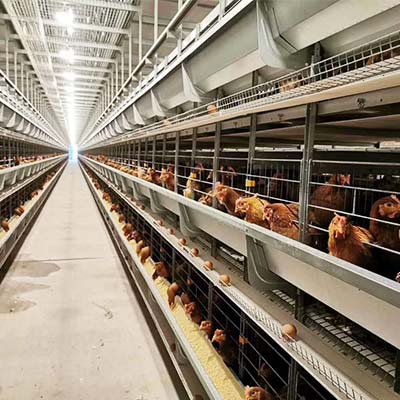How to configure feed for laying hens?
- font size decrease font size increase font size
Nutritious feed allows laying hens to maintain good growth and performance. However, in the process of preparing feed, we must pay attention to rationality and science. Many farmers have many misunderstandings. Here are 6 precautions for chicken cage manufacturers to prepare feed for farmers.
- The salt content should not be too high: salt is a raw material that must be added in the process of preparing feed, which can enhance appetite, prevent feather pecking and anus pecking, and cause laying hens to be thirsty.
- The amount of stone powder added should not be too high: Stone powder is also a raw material that farmers often add when formulating feed, but farmers need to pay attention to whether the amount of stone powder added in the diet is too much or too little. If the increase is too fast, it will lead to excessive calcium in the blood of laying hens, increase the burden on the kidneys, cause the kidneys to swell, and eventually lead to diarrhea. When formulating feed, Ireminded farmers that the amount of stone powder should be gradually increased with the increase of laying hens' egg production rate. Do not add too much at one time.
- The crude protein content should not be too high: protein is an essential nutrient for laying hens. Some farmers believe that adding more crude protein can make hens lay larger eggs and improve the quality of laying hens. This is a wrong idea, because the crude protein is so high in soybean meal. If it is added too much, it will cause incomplete absorption by the human body, stimulate the intestinal tract, accelerate the metabolism, cause the chicken manure to turn yellow and thin, and the feed conversion rate will decrease.

- The feed formula should be relatively stable. If the feed needs to be replaced, it is best to adopt a gradual transition method to avoid loss of appetite and digestive disorders.
- Prevent mildew of raw materials: It is summer now, high temperature and high humidity can easily lead to mildew of feed. Moldy feed farmers cannot feed laying hens, because the moldy feed contains some toxins, which will stimulate and destroy the intestinal mucosa of laying hens, thereby increasing the permeability of the intestinal mucosa of laying hens and causing diarrhea in laying hens.
- Feeding can be added once at night. It can not only prevent chickens from being hungry at night, but also increase the energy intake of laying hens. Maintain a high level of laying hens.
The above is the chicken cage manufacturer to adjust the feed formula of laying hens in 6 ways for everyone. The adjustment of laying hen feed is not too difficult, and farmers can refer to the content in the article. This is also the key knowledge of using the battery layer cages breeding technology to ensure that the laying hens can obtain rich nutrition and maintain a high egg production.

